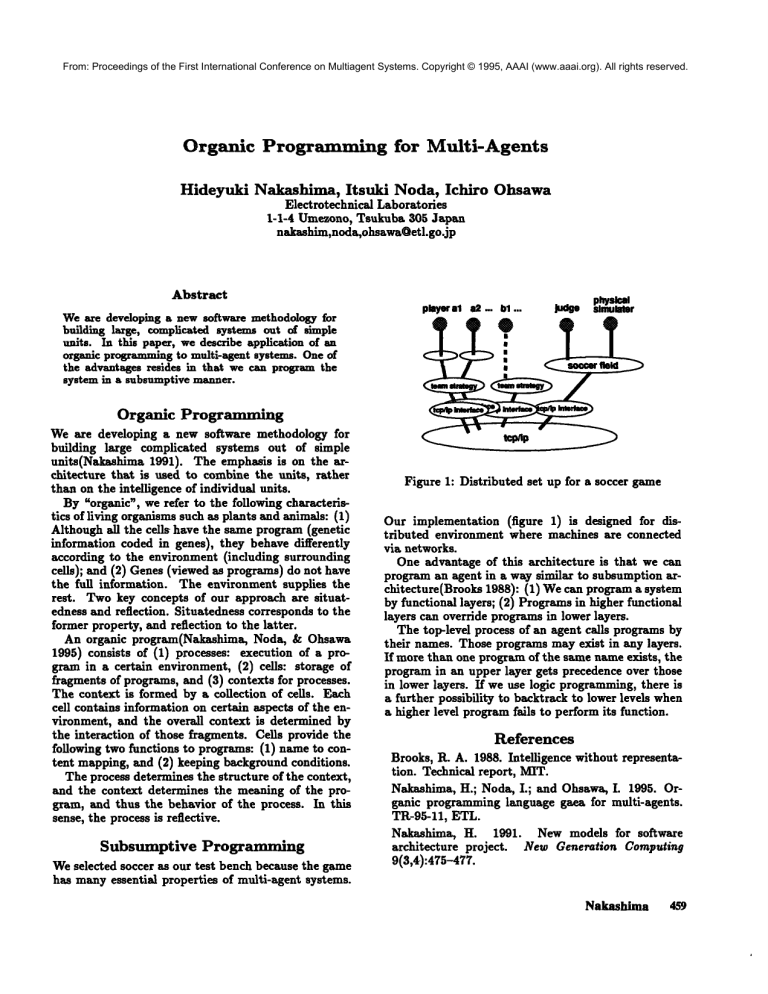
From: Proceedings of the First International Conference on Multiagent Systems. Copyright © 1995, AAAI (www.aaai.org). All rights reserved.
Organic
Programming
for
Multi-Agents
Hideyuki Nakashima, Itsuki Noda, Ichiro Ohsawa
Electrotechnicai Laboratories
1-1-4 Umezono, Tsukub~ 305 Japan
nakashim,noda,ohsaw~Qetl.go.jp
Abstract
Weare developing a new software methodology for
building large, complicated systems out of simple
units. In this paper, we describe application of aa
orglmic progr~mrniugto multi-agent systems. One of
the advantages resides in that we can program the
system in a subsumptive manner.
players1s2-. bl...
physical
Judgeslmulater
@
Organic Programming
We are developing a new software methodology for
building large complicated systems out of simple
units(Nakashima 1991). The emphasis is on the architecture that is used to combine the units, rather
than on the intelligence of individual units.
By "organic", we refer to the following characteristics of living organisms such as plants and animals: (1)
Although all the cells have the same program (genetic
information coded in genes), they behave differently
according to the environment (including surrounding
cells); and (2) Genes (viewed as programs) do not
the full information. The environment supplies the
rest. Two key concepts of our approach are situatedness and reflection. Situatedness corresponds to the
former property, and reflection to the latter.
An organic program(Nakashima, Noda, & Ohsawa
1995) consists of (I) processes: execution a program in a certain environment, (2) cells: storage
fragments of programs, and (3) contexts for processes.
The context is formed by a collection of cells. Each
cell contains information on certain aspects of the environment, and the overall context is determined by
the interaction of those fragments. Cells provide the
following two functions to programs: (1) name to content mapping, and (2) keeping background conditions.
The process determines the structure of the context,
and the context determines the meaning of the program, and thus the behavior of the process. In this
sense, the process is reflective.
Subsumptive Programming
Weselected soccer as our test bench because the game
has manyessential properties of multi-agent systems.
Figure 1: Distributed set up for a soccer game
Our implementation (figure 1) is designed for distributed environment where machines are connected
via networks.
One advantage of this architecture is that we can
program an agent in a way similar to subsumption architecture(Brooks 1988): (1) Wecan program a system
by functional layers; (2) Programsin higher functional
layers can override programs in lower layers.
The top-level process of an agent calls programs by
their names. Those programs may exist in any layers.
If more than one program of the same name exists, the
program in an upper layer gets precedence over those
in lower layers. If we use logic programming,there is
a further possibility to backtrack to lower levels when
a higher level programfails to perform its function.
References
Brooks, R. A. 1988. Intelligence without representation. Technical report, MIT.
Nakashima, H.; Noda, I.; and Ohsawa, I. 1995. Organic programming language gaca for multi-agents.
TR-95-11, ETL.
Nakushima, H. 1991. New models for software
architecture
project. New
Generation Computin
9
9(3,4):475-477.
Nakashima
459




